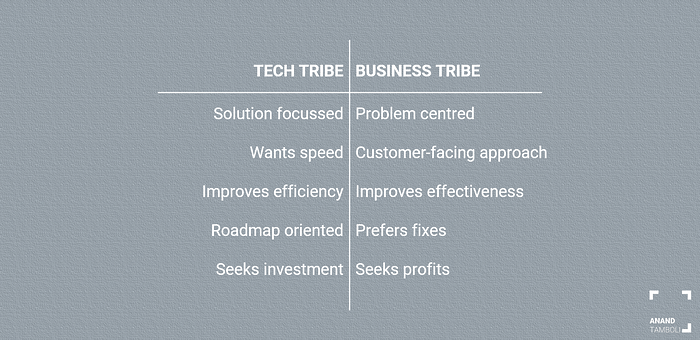While working with over 85+ businesses of various sizes in the last 20 years, I discovered a characteristic pattern in the companies that were the best and the rest. I have tried to model this into an explainable and understandable form here as The Sanity Model.
As I depict in this model, a business must walk the fine line to remain in the safe zone. While the technology-first approach is a definite way to upset the customers, the right balance is necessary to sustain the customer-first approach.
Businesses often get carried away by the smart technology at the disposal and assume that we can use it to solve every problem around us. Emerging technologies are new hammers; avoid treating all the issues as nails.
You must avoid rushing into the emerging future. Instead, deliberate efforts, coupled with thoughtful steps, can yield long-lasting positive results. This approach is crucial because it is challenging to undo strategic and technological mistakes these days.
These days, technology solutions are more likely to go wrong due to incompetence rather than malice.

Balancing Technology & Business — The Sanity Model © 2019 Anand Tamboli
Introducing — “The Sanity Model”
In any organization, typically, there are two tribes or groups. One group belongs and subscribes to its management & business aspects while another subscribes to its technological aspects. Quite often, there is a gap and philosophical differences between the two.
The tech-tribe often favors solutions, wants speed to improve efficiency, depends on work-roadmap, and seeks investment.
On the contrary, the business tribes' preference is to focus on problems, have a customer-facing approach, improve the effectiveness of business overall, prefer fixes over proper solutions, and seek profits.

Tech-tribe and business-tribe have different focus areas and preferences, which drive different behaviors.
If there is a right balance of business-sense and tech-sense, then the outcome is growth (the 1st quadrant). A business would see consistent and sustainable growth along the sanity line. A slight imbalance usually results in a minor nuisance or shift of focus. However, as long as you are on top of it, it is okay. Understand the need to restore the balance, and have a plan to do that.
The exact opposite of this situation is a combination of lousy business-sense and tech-sense, which is undoubtedly a good recipe for doom (the 3rd quadrant).
The other two quadrants represent the lack of either of it; either the business has excellent tech-sense but poor business-sense, or it is the opposite. In each case, one tribe is frustrated due to another. Also, most importantly, the customer, in both cases, would be frustrated and get close to no value from the business’ product or service. Being there for a long time usually pushes the company into the doom quadrant.
We know of several organizations or brands, which we like in general but always wish to use better technologies to serve us (Q4 types).
Moreover, there are several examples of technology implementations where they did not honor the business aspect. These implementations have either seen an outright failure or have an inferior yield (Q2 types).
You can pick up any brands you deal with regularly or know of and try to put them in this model. You will observe a pattern too.
Here are a few examples
I described an incident in one of my previous posts here. It happened in the early days of my career. This company was a classic example of a Q3 scenario (poor business and tech-sense). The said company has been going through insolvency proceedings for the past one year.
A well-known example of a company that could fit in Q2 (only good tech-sense) would be Nokia. We all loved Nokia phones at one point in time; however, business-sense did not prevail (soon enough) in favor of customers. Unfortunately, this approach pushed the company downwards in Q3, where their technology lagged and eventually became irrelevant.
Banks are probably the closest examples that could fit in Q4 (not so good, but average business-sense and lack of tech-sense). Many banking institutions are relatively better from a customer point of view and overall business sense. Perhaps that is inherent due to the conservative nature of their business or regulatory frameworks. Nonetheless, their tech-sense is slow and often far behind general advancements. Those banks, which lack tech-sense usually get pushed sideways in Q3 (of doom). The ones at least maintain business-sense stay in Q4 and frustrate us all the time.
The 13 principles for sanity
Maintaining the balance between technology and business sense is not easy. Moreover, the speed at which changes are happening, thanks to emerging technologies, makes it challenging to do it. However, it is not rocket science per se. It instead needs evolved principles that could become actionable guidelines.
If you want to maintain some level of sanity in business, the following principles will help:
1. Remain skeptical: Maintain a position that technology is not a panacea — it takes the right combination of people, process, technology, and timing to achieve the best results. Being skeptical doesn’t hurt, but don’t overdo it.
2. Do not over-speed: Do not rush. Take some time to think and reflect on consequences, then build safety nets for negative impacts before taking any steps. Over-speeding kills, on roads or otherwise!
3. Insist on a kill-switch, exit, or roll-back option: Contemporary solutions are more than packaged software these days. Whether or not they are sophisticated AIs, they are still intricate pieces of intertwined technologies. The inability to roll-back or stop puts you in a severely disadvantaged position. Insist on having these options handy.
4. Demand quality: And more importantly, define it in the first instance. Shifting goal-post is a common scenario in several organizations and can be detrimental to the quality aspect. If you define your goals and acceptance criteria up-front for any project or activity, it will avoid the temptation to force-fit results.
5. Seek transparency in technology: Knowing your technology's inner mechanics is as important to you as knowing how your employees think and their general behavior. Without that, you will be continuously dealing with the uncomfortable unknown, creating an intellectual debt.
6. Seek interpretability: One should explain the relationship as Y = f(X). Here ‘Y’ is the outcome (or outcomes), and ‘X’ is the driver (or multiple drivers) of that outcome(s). Knowing why the technology works in a certain way, and being able to explain it is essential.
7. Demand simplicity: Nothing beats simplicity. It gives you better control over the situation, a technology, or a process. Too many convoluted things in business (tech or otherwise) can cause sheer waste of valuable resources and distract you from the core purpose.
8. Ensure accountability: Without accountability, it is often difficult for people to value their work. When done right, accountability helps increase skills and confidence. However, note that it does not mean controlling.
9. Educate everyone: There is always a need to invest some time acquiring education about new technologies you are using or planning to use. Knowing would enable you to ask the right questions at the right time/steps. Being more involved is necessary; education is one right approach for that.
10. Take user feedback seriously: If you consume customer (internal or external) feedback but never consider or act on it, it remains an open-loop system. The open-loop system is not stable. Ensure that your feedback loop is active, and everyone in that loop is sincerely learning from the feedback received.
11. Prefer pre-emption over fix: Focus and prefer pre-emptive systems than fixers. Both are important, but if you must — prevention is always better than repair. For urgent needs fixing an issue (band-aid solution) is imperative; however, you must eradicate the problem in the long-run.
12. Being responsible: Just because you can do something — does not mean you should do it. The responsible approach is a central requirement to work and handle powerful technologies and systems.
13. Apply phronesis/sanity lens: Merely intellectual prowess is not enough. Phronesis is the wisdom relevant to practical action, implying both sound judgment and excellence of character & habits or practical virtue. It is challenging and sometimes nearly impossible to undo strategic and technological mistakes these days. Sanity is the key!
In a gist
Being curious when you hear only one side of the argument can be tremendously helpful. Asking the right questions out of this curiosity can peel off several aspects, especially when working with emerging technologies.
Business and technology challenges are evolving steadily, as computers become more pervasive and take part in our daily life in many ways. As technology adapts and changes, there could be new risks in the future. So the golden rule should prevail — maintain a balance!
A good balance would mean the right proportion of optimism, pessimism, and skepticism.
That brings me to the question I would like readers to ponder: how can we pragmatically march towards a better future and growth without losing the balance?
